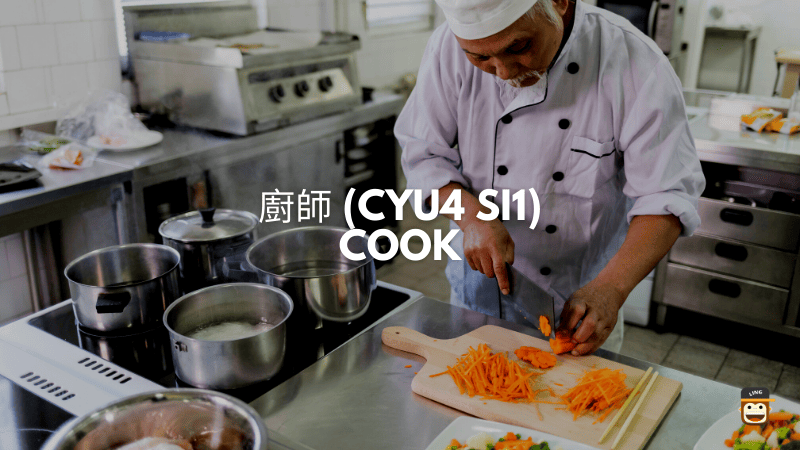Are you wondering what the common Cantonese cooking verbs are? Having the ability to express your opinion when it comes to the matter of cooking or 廚師 (Cyu4 Si1) is an important skill to master if you want to connect with the locals. As we all know, the easiest way to start a conversation is by talking about exciting topics, like food preparation. Let’s learn more about this in the sections below.
Cooking involves many different processes making it a complicated thing for total beginners in the kitchen. It involves multiple processes, from preparing, cooking, plating, serving, and even cleaning. In cooking, there’s a lot of different methods involved. These methods are needed to be done appropriately to make the food taste delicious as it was supposed to be.
Cooking methods vary on the ingredients used in cooking a certain dish. It is also common for a country to have the most preferred cooking method based on its diet and abundant ingredients. So, in this lesson, we will learn about Cantonese cooking verbs.
Cantonese Cuisine
Before learning the Cantonese cooking verbs, let’s briefly overview Cantonese cuisine.
Cantonese Cuisine, also known as Yue Cuisine, is one of the most famous cuisines globally that originated from the Guangdong province of Mainland China. It is also the cuisine that you will taste when you go to Hong Kong.
If you have been eating Chinese food from different parts of the world, such as Chinese steamed eggs, Char Siu, White Cut Chicken, and Dimsum, Cantonese cuisine is the most widely served style of Chinese cuisine. This happened because the Chinese people who migrated to different parts of the world were the ones who built Chinese restaurants, so it’s no surprise that there are plenty of them worldwide.
Cantonese cuisine’s flavors are mild, natural, fresh, and sweet. The main goal of this cuisine is to bring out the food’s natural flavor. If these are the flavors, the resulting dishes will be bland for those new to Cantonese Cuisine. For someone who is used to flavorful food like the Western style, it may take a while to appreciate the distinct flavor of Cantonese Cuisine.
Quick Tip: Interested in impressing the locals truly? There’s a lot more to discover about Cantonese cuisine, and you can read more about authentic Cantonese flavors, traditional Cantonese food, and Cantonese cooking utensils in our posts here at the Ling App.
Cantonese Chinese Dishes
Have you ever tasted authentic Cantonese food? These dishes are mostly lightly cooked fresh vegetables and meat and sweet sauces. The seasonings that are mostly used in cooking Cantonese dishes are those that give mild tanginess to accentuate the flavor of the food. They use coriander leaves, chives, anise, black pepper, and slivers of ginger. For the sauces, they mostly use hoisin sauce, oyster sauce, sweet and sour sauce, plum sauce, and soy sauce.
So, what are the famous Cantonese dishes that we usually see in typical Cantonese restaurants?
Chinese Steamed Eggs
This dish is made of eggs that are beaten until it becomes creamy. After this, it will be steamed. Some variety involves adding other ingredients like soy sauce and spring onion.
White-Cut Chicken
This is a very famous dish, especially for those people who are living in the Pearl Delta River. What’s good about White-Cut Chicken is that it is easy to prepare. It is made of salt-marinated chicken, and it is cooked in hot water or chicken broth with ginger using a wok it a ceramic casserole. You will definitely see this in a typical Cantonese restaurant menu, and it is sometimes served with scallions, minced ginger, liquid pork fat, or vegetable oil.
Cantonese-Style Roast Goose
Another famous Cantonese dish is made by roasting a goose with seasoning in a charcoal furnace. What you’ll about this are the crispy skin and the juicy, tender meat.
Cantonese Cooking Verbs

Have you ever wondered why Cantonese food is so tasty? It is because of the distinct flavors and cooking methods used by chefs. So, in this part, we will learn about words related to Cantonese cooking verbs. Do not worry because every word or Cantonese Chinese vocabulary will have romanizations and English translations to help you develop your language skills. This useful Chinese vocabulary about cooking terms can be used in case you’re interested in cooking your own dish based on a Cantonese recipe.
廚師 (Cyu4 Si1) – Cook
Of course, one of the main Cantonese cooking verbs that you should learn is cook 廚師 (Cyu4 Si1). It is the process of preparing food by combining, mixing, and heating ingredients.
蒸 (Zing1) – Steam
The most preferred cooking method in Cantonese cuisine is steaming 蒸 (Zing1). It is a cooking method that is done by placing food in a steamer which is placed on top of a hot liquid. Boiling is one of the easiest cooking methods, but it takes a while, especially if you are cooking beef. When you reach the required heat, boil the ingredients until it becomes soft.
煮 (Zyu2) – Boil
Boiling 煮 (Zyu2) is the process of cooking food in water with very high heat that reaches 100° Celsius, which is the boiling stage. This method allows ingredients completely immersed in water and boiled until it becomes tender and soft.
煎炒 (Zin1 Caau2) – Stir-Fry
Stir-fried food is also one of the most popular foods of Cantonese Cuisine. Stir-frying 煎炒 (Zin1 Caau2). This is an authentic Chinese cooking technique where ingredients are stirred or tossed in a wok while being fried in a tiny amount of very hot oil. If you have vegetables at home and some Cantonese sauces like hoisin or oyster sauce, just grab a wok and quickly stir-fry it. If you also love partially-cooked food, this is the perfect method for you.
炸 (Zaa3) – Deep Fry
Do you want to achieve a crispy texture of food, deep-frying 炸 (Zaa3) is the best cooking method for that. In this method, food is cooked in hot oil or fat. This will take a long time because you have to wait until the color turns a golden brown.
煎 (Zin1) – Pan-Fry
Pan-Frying is also one of the most important Cantonese cooking verbs to learn. In deep-frying, we use a huge amount of oil to completely submerge the food, but in pan-frying, we will only use a small amount of oil or fat, just enough to lubricate the pan if you’re cooking greasy food like bacon, no need to put oil or fat.
烤 (Haau1) – Roast
Roasting 烤 (Haau1) is a cooking method that is somehow similar to baking because it uses an oven. In roasting, meat and vegetables are cooked using dry heat where hot air covers the food. This is the reason why it is cooked evenly on all sides.
燴 (Wui6) – Braise
Braising 燴 (Wui6) is another Cantonese cooking verb to learn. This method cooks meat or vegetables by slowly heating them with moisture and oil. This is done on a tightly sealed vessel.
焗 (Guk6)- Bake
We usually associate baking 焗 (Guk6) with pastries that are commonly consumed as deserts, but it’s not always that way. Baking is a cooking method that uses dry heat like an oven, hot stones, or ashes.
烤 (Haau1) – Grill
We cannot leave out grilling 烤 (Haau1) to our list of Cantonese cooking verbs. This method also involves cooking in dry heat. This is applied to the surface of the food that involves a significant amount of radiant, direct heat. This is a quick method to cook meat and vegetables.
Unique Chinese Cooking Methods
As mentioned above, Cantonese cuisine is a famous cuisine worldwide, so it is no surprise that they have unique methods of cooking that they usually use in cooking. Here are some of these methods.
红烧 (Hung4 Siu1) – Red Cooking
The red cooking method involves cooking over prolonged heat. This is done with the ingredients completely submerged in a soy sauce-based broth.
爆 (Baau3) – High Heat Stir-fry
This rapid method stir-fries the ingredients in a wok with a lot of oil, sauce, or broth at high heat. It’s supposed to have a crispy texture without being overcooked.
焖 (Mun6/Man1) – Stewing
You might be familiar with Western-style stewing, but it’s not like that in Chinese. In this method, the ingredients are stir-fried until they are half done, then they will be transferred to a clay pot to simmer cook.
炖 (Dan6) – Gradual Simmering/Double Boil
There is also another cooking method similar to boiling, which is simmering or double boiling. This is the cooking method best to use when cooking delicacies such as Bird’s Nest Soup. Since this is the most preferred cooking method, it is really a must to add this to our list of Cantonese cooking verbs to learn.
烩 (Wui6) – Hui
This cooking method is also referred to as braising. The only difference is it is thickened with a starchy gravy at the end.
Other Cantonese Cooking Verbs
Here are other Cantonese cooking verbs to add to your vocabulary:
| Cantonese | Jyutping | English Translation |
| 拌 | bun6 | dressing |
| 切 | cit3 | cut |
| 剁 | doek3 | chop |
| 加熱 | ga1 yit6 | (to) heat |
| 冻 | dung3 | jellifying |
| 腌 | jim1/jip3 | marinating |
| 剁碎 | doek3 seoi3 | mince |
| 撈 | lou1 | mix |
| 去皮 | heui3 pei4 | peel |
| 準備 | zeon2 bei6 | prepare |
| 放 | fong3 | put |
| 洗 | sai2 | wash |
Innovative Language Learning Awaits Here At The Ling App!
As the world becomes digital, email communications and learning languages can be done conveniently using a gadget and the internet. That’s a gift of modern technology that we should embrace and make use of to improve our lives as humans. Because of this improvement, lots of innovative language learning tools emerged, and one of these is Ling App.

By signing up for a free lifetime account with the Ling App by Simya Solutions, you will be able to have access to a variety of lessons or topics in different languages. Learning will be fun and engaging because you’ll encounter mini-games and quizzes that will keep you on track. You can also use what you have learned in dialogues and talking to chatbots. If you want extensive grammar tips or cultural relations of the topics you’re learning, don’t worry because they are all provided by Ling App.
So, waste no time and learn Cantonese now with the Ling App!


















